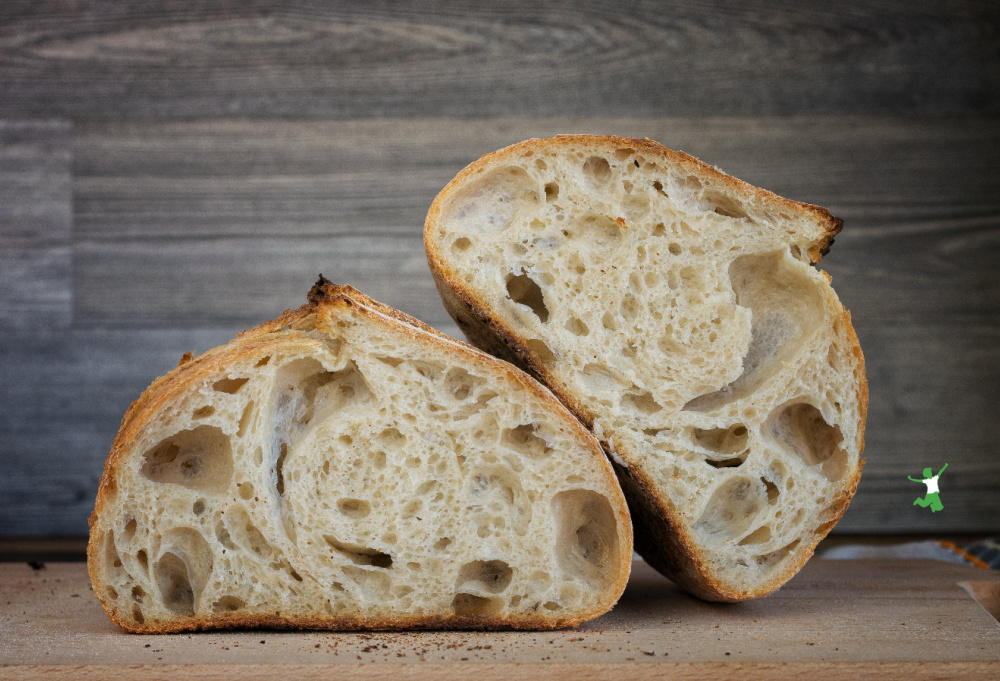Table of Contents[Hide][Show]
Research suggests that people with celiac disease tolerate sourdough bread where the dough is fermented with a specialized sourdough starter in accordance with traditional methods.

Buyer beware! Most breads labeled as “sourdough” on the market today are anything but…
These fake sourdough breads typically contain yeast and/or a sweetener.
This is an easy giveaway clue that the bread is a phony and should be avoided if one seeks a traditionally baked loaf.
Baker’s Yeast Is Not Traditional
When baker’s yeast was first introduced in France as an alternative to sourdough starter in the mid-1600s, it was strongly rejected!
The scientist-noblemen of the day knew that it would negatively impact people’s health. When the Faculty of Medicine decided to formally examine the question, they banned its use. (1)
True sourdough bread does not contain baker’s yeast. Instead, a Lactobacilli-based starter culture is used.
In addition, authentic sourdough is baked at a lower temperature for a longer period of time.
These methods protect the integrity of the cereal grains and preserve nutritional value.
What’s more, anti-nutrients such as phytic acid are eliminated, and gluten, that very difficult-to-digest plant protein, is significantly broken down.
As a practical bonus, sourdough bread stays fresh longer than yeasted bread.
Despite the initial rejection of baker’s yeast, the convenience aspect of quick-rise yeasted loaves resulted in widespread adoption over the last century.
It is no surprise, then, that the skyrocketing cases of gluten intolerance and celiac disease have risen in lockstep over the decades.
Why did pre-industrialized people groups consume gluten-containing breads with no digestive difficulty whatsoever?
Could it be that the traditional preparation methods were somehow protective?
Sourdough and Celiac
The peer-reviewed Journal of Applied and Environmental Microbiology researched this very question, publishing a study conducted in Europe that examined how celiacs tolerate true sourdough bread. (2)
Seventeen people suffering from celiac disease were given 2 grams of gluten-containing bread risen with either baker’s yeast or a Lactobacilli culture.
Thirteen of the seventeen participants showed negative changes in intestinal permeability consistent with celiac disease. Four participants did not show any negative changes.
Then, all the study participants were given true sourdough bread fermented with a special Lactobacilli culture able to break down the primary amino acid building block that causes an immune response in people with celiac.
None of the study participants showed any negative changes in their intestinal permeability after consuming the bread baked using 30% wheat flour and a mix of oat, millet, and buckwheat flour.
The researchers’ conclusions were summarized as follows:
These results showed that a bread biotechnology that uses selected lactobacilli, nontoxic flours, and a long fermentation time is a novel tool for decreasing the level of gluten intolerance in humans. (3)
What I find interesting about the study is that even when the people who consumed the wheat bread baked with either baker’s yeast or a normal Lactobacilli culture, four (nearly one-quarter) did not show any negative changes to their baseline values of intestinal permeability.
Did these people consume bread raised with a normal sourdough culture?
If so, perhaps even regular sourdough cultures would be sufficient for some celiacs to consume.
Certainly, most with simple gluten intolerance would find true sourdough bread to be easily consumed with no digestive distress.
It seems that the noblemen in the court of Louis XIV of France had it right all along.
Abandoning the traditional methods of bread preparation in favor of baker’s yeast would have disastrous effects on people’s health.
Little did they know that their wisdom several centuries later would be termed “novel” by scientists in the biotechnology industry!
(1) History of Baker’s Yeast
(2, 3) Study Finds Wheat-based Sourdough Bread Started with Selected Lactobacilli is Tolerated by Celiac Disease Patients
More Information
No-Knead Einkorn Sourdough Bread
The Good Gluten You Can Probably Eat Just Fine
The Real Reason Wheat is Toxic (It’s Not the Gluten)








Check out “wheat belly ” on Facebook, Dr. Davis claims it’s wheat that is causing all our health issues, I just purchased his book, looks good:)
Thanks for all you do Sarah in educating people about real foods.
This is an interesting article, and of course, many of us that are gluten free would love to go back to eating crusty sourdough bread… but is trying it worth the risk? Thomas O’Bryan, MD (thedr.com) describes cases where people who were gluten-free went back onto gluten just to be officially tested for Celiac and then had major health setbacks with irreversible damage.
A big problem is that wheat has been hybridized to contain a LOT more gluten than it did 2000 years ago.
Gluten “intolerance” is not milder than Celiac or less sensitive to gluten, it is just manifesting in other ways. The immune system might not be attacking the gut, it might be attacking the thyroid, the brain, or the skin. And many Celiac’s do not have gut symptoms. For more info, check out the web site I mentioned above. Dr. O’Bryan is gluten intolerant.
Whoops, my fingers slipped! Dr. O’Bryan is a DC, not an MD.
I would love to believe that sourdough gluten bread is safe but, as a celiac myself, I’m not sure I want to find out the hard way. Some celiacs have silent symptoms that don’t affect the bowel but create severe fatigue over time and I don’t want to go back there. :0)
I”m sorry to say that this piece is dangerous. From the comments it already appears that people are going to try eating sourdough bread if they have celiac.
I can’t say this clearly enough: even if made by a sourdough starter, bread made from wheat flour still contains wheat. It contains gluten. Sourdough bread will make someone with celiac sick.
A study of 17 people (17 people?!) is not nearly big enough to be statistically accurate for anything. Please, please don’t post something like this unless there is solid science.
Christy, you said that kneading the dough for 20 minutes “develops the gluten.” You’re right. It develops the gluten. Gluten.
It’s possible that those who are gluten intolerant or gluten sensitive might have fewer reactions to bread that is made from sourdough. However, for those who have celiac, only 1/8 of a teaspoon of gluten is enough to damage the intestines and set off the autoimmune reaction. And there are many with celiac who don’t have big outward symptoms. They could now go out and buy sourdough and be making themselves sick after reading this article.
Exactly! It’s not something you play around with! The reason most celiac cases are undiagnosed is because many have NO DIGESTIVE SYMPTOMS! It’s not a great indicator of what’s going on with your autoimmune responses.
Every line of content is nice and helpful. thanks to Sarah.
Hi Sarah,
Is it ok to eat sourdough if it is made with white flour?
Thanks so much,
Mary
Make your own sourdough’d white spelt, not wheat, and ferment/culture using the natural inherent wild yeast in the air and already on the flour for I’ve read 3 days to really break down the easier to digest gluten and carbs. as well.
Thank you for this article, Sarah! I used to make the Nourishing Traditions sourdough with Rye and Spelt ages ago. For about 2 years, I only made that bread, it was so easy. Then I transferred to all spelt. I wanted variety so began sprouting and making regular breads. Since then I have become gluten intolerant and never even thought about trying sourdough again! The key with sourdough is to make sure you wait until the starter is bubbly to use it in your baking. Timing is so key. Do not let it bubble and then go flat again. If you do, you need to feed it again, but don’t make bread with flat starter or else it will not rise. I got rid of all my wheat grains but I still have a huge bucket of spelt so I will incorporate this again! If anything, I remember sourdough being so easy, and I am the only GF one in the family, so at least so the family can have “normal” bread again! 🙂
Nickole
Can Celiacs Eat True Sourdough Bread? – The Healthy Home Economist
http://ow.ly/6aE5Y
I learned how to make a starter and bread from a great online course at GNOWFGLINS.com. The subscription is good for a year and she really explained everything in detail with video demonstrations and the science behind it. You have to pour off some starter in the beginning so that the colony of yeast get’s stronger and the yeasts proliferate. I just divided mine and kept a few going at the same time. There were great recipes on the website for using your starter to make cakes and potpies, traditional pita, cookies, etc… There are also other lessons on traditional food prep. That you have access to with the subscription. It really helped me hone my kitchen skills. I bake fresh sourdough bread every week now. It’s delicious!
Good luck out there. It’s worth the effort to figure it out.